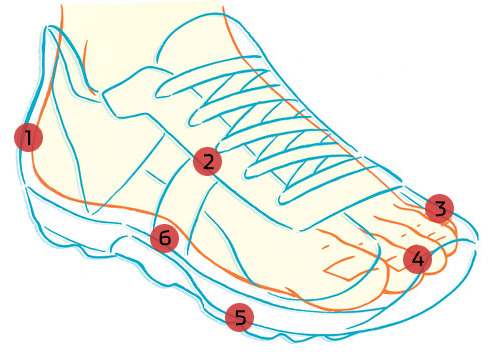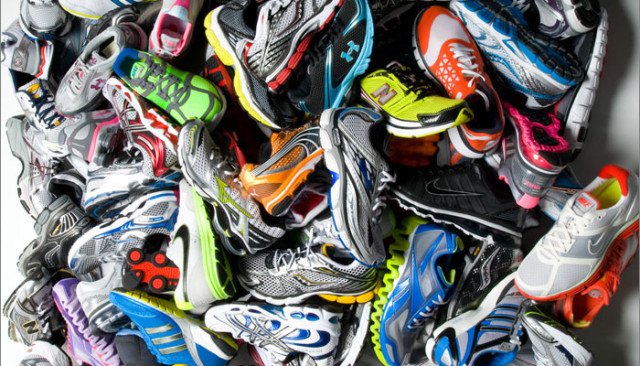How to Buy the Right Running Shoes
Buy the right running shoes with these four shoe-buying strategies that won't leave you tied up in knots.
Buy the right running shoes with these four shoe-buying strategies that won’t leave you tied up in knots. – By Matt Allyn
Finding the best-fitting shoe among the many choices at your local running store isn’t always easy. To ensure you walk out with happy feet, you need to make sure the shoe fits properly from heel to toe. We asked two prominent specialty-running-store owners – each of whom has fitted thousands of runners – to share some of their secrets.
Knowing what to look for will give you a better idea how your next pair should feel on your feet.
1. Heel
Your heel should fit snug, but not tight, says Carl Brandt. “Laced up (but not tied), you should be able to slide your feet out.” Lacing your shoes up through the final eyelet minimises slippage. There will be some heel movement, but it shouldn’t be uncomfortable. Any irritation you feel in the store, adds Brandt, will be amplified once you hit the road.
2. Instep
A shoe’s upper should feel snug and secure around your instep, explains Brandt. “When people tell me they feel pressure and tightness, they need more space.” If an otherwise great shoe has hot spots or pressure under the laces, try lacing it up a different way before moving on to the next shoe.
3. Width
Your foot should be able to move side-to-side in the shoe’s forefoot without crossing over the edge of the insole. You should be able to pinch half a centimetre of upper material along the widest part of your foot. If the shoe is too narrow, you’ll feel the base of your little toe sitting on the edge of the shoe last.
4. Length
Feet swell and lengthen over a run, so make sure there’s a thumb’s width of space between your longest toe (which isn’t always the big toe) and the end of a shoe. A friend or shoe fitter can measure this while you stand with your shoes laced up. “Your toes should also wiggle freely up and down”, explains running store owner Chet James. “Wiggle room protects against front-of-the-foot issues.”
5. Flex
Check the flex point before you put on the shoe. You can do this by holding the heel and pressing the tip of the shoe into the floor. The shoe should bend and crease along the same line your foot flexes. An improperly aligned flex point can lead to arch pain or plantar fasciitis, while a lack of flexibility leads to Achilles-tendon or calf strain.
6. Feel
Knowing your arch type or running mechanics isn’t the whole story. You still need to pinpoint shoes that match your foot’s contours and movements. You can’t get a good feel by just standing, says James. So take your shoes for a quick jog, either on a store’s treadmill, on the sidewalk, or down a hallway. A natural-feeling support under the arch works for most people, James says. “Back off the amount of support if you feel your arch cramping.” Your shoe should complement and support your stride, not try to alter it.
Avoid Common Shoe-Buying Mistakes
Specialty running store staff see runners making the same mistakes again and again when they come in to buy shoes. But not you, not anymore, thanks to this four tips.
Mistake #1: Buying for looks.
“Some runners are too concerned with fashion, and we try and steer people away from that. Often, when they get a shoe that looks cool, they end up coming back in a few months and saying, ‘This shoe hurts me. I had a problem with it.’ When you buy, think feel and fit, not fashion.” said Bryan Mahon, owner of a running store.
Mistake #2: Buying shoes that are too small.
Tight-fitting shoes lead to blisters and black toenails and that kind of thing. Women in particular are used to wearing their shoes close-fitting, as they’re often more self-conscious about the size of their feet.
Mistake #3: Shopping at the wrong time of day.
“A lot of times people come in the morning and say, ‘This is the shoe I need.’ Then they’ll come back the next day and say, ‘I wore them at 5 p.m. and they were too small.’ Your feet start swelling in the morning and they don’t stop until about 4 p.m. That’s as big as they’re going to get, so always buy your shoes in the evening.” recommended Tish Borgen.
Mistake #4: Assuming your size.
“People assume that a size is a size – that a US 8 in a Nike will be the same as a US 8 in a New Balance. But sizes differ because of different lasts (foot forms), the different shape of the upper, and the way the shoe is stitched together. Have your feet measured every time you buy, and always try the shoes on for fit.” explains Johnny Halberstadt, running store owner.


